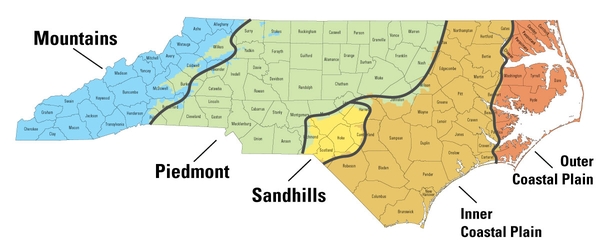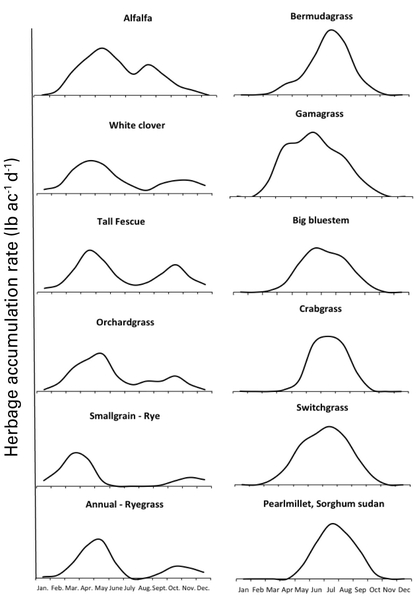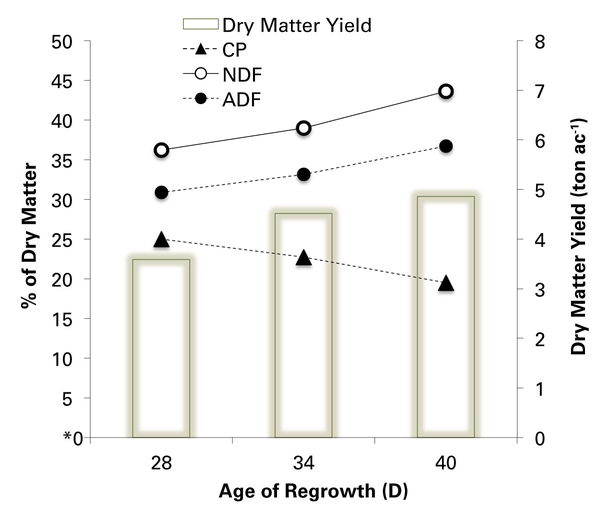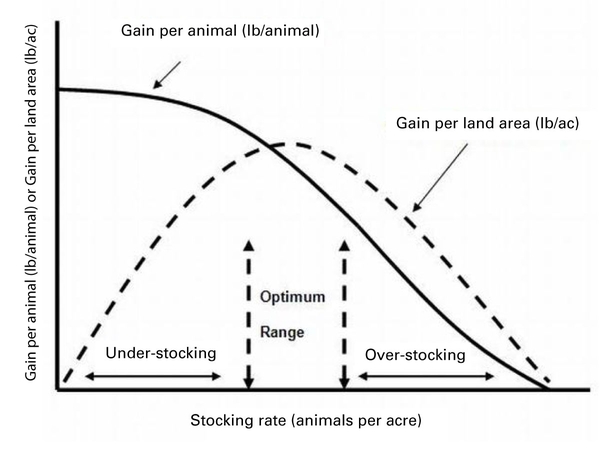General Guidelines and Concepts
Forage is defined as edible parts of plants, other than separated grain, that can provide feed for grazing animals or that can be harvested for feeding. This definition includes grasses, legumes, browses, small grains if fed during the vegetative stage, and corn if fed as silage. Adapted species range from annual and perennial cool-season to warm-season grasses and legumes (Table 1). The diversity in forage species that can be grown in North Carolina is in part due to the geographic location of the state (between N 33.5° and 37°), in what is recognized as the “transition zone”—the area between the cool/humid climate of the northern region of the United States and the warm/humid climate of the southern region. This area is also referred to as the “tall fescue belt” because tall fescue, which is a cool-season perennial grass, is the dominant forage species. Cool-season species thrive when temperatures range from 65°F to 75°F, and warm-season species thrive when temperatures range from 80°F and 95°F. Hence, the time of year when availability is highest from cool- and warm-season forage varies in North Carolina and sometimes overlaps, depending on the forage species. Cool- and warm-season forages can be either annuals (live for one season) or perennials (live for multiple seasons).
Soil characteristics also determine where some species are best adapted. The combination of geology (composition) and geomorphology (soil formation processes) has resulted in four major North Carolina soil regions: coastal plain, sandhills, piedmont, and mountains (Figure 1). Soil chemical and physical characteristics can vary considerably within a soil region, and sometimes even within the same field. In general, soils across the North Carolina coastal plain and sandhills are sandy to sandy-loam, in the piedmont they are clayey to clay loams, and in the mountains they are fine loamy to sandy clay loams. Agronomically, the North Carolina coastal plain and sandhills have been the major row and vegetable crop–producing regions, whereas the piedmont has been a mixture of cropping systems with dairy and beef presence and the mountains have been dominated by beef cattle production with some cropping present.
Weather conditions (including rainfall and temperature), soil conditions (including moisture and temperature), and management practices (including establishment; fertilization; frequency and intensity of forage defoliation; management of weed pressure) determine the short-term productivity of forage species and, most importantly, its persistence. The traditional perennial forage species grown in the North Carolina coastal plain and sandhills have been bermudagrass, bahiagrass, and dallisgrass (Table 1). In the piedmont, tall fescue has dominated, whereas in the mountains, Kentucky bluegrass and white clover pastures have dominated, although orchardgrass is also well adapted.
Establishing large acreages to forages can be costly and time-consuming. Thus, deciding which species to plant must involve careful consideration of (1) the system’s main objectives, (2) which forages most closely match those objectives, and (3) which management decisions have the greatest impact on success.
Production Systems
Forages can provide feed for animals through grazing or be stored and shipped as hay, silage, or haylage for subsequent feeding to livestock during periods when forage for grazing is in short supply. In addition, forages can be included as part of crop rotation systems, as receiver crops to recycle animal wastes (for example, bermudagrass in the coastal plains spray fields), for biomass production for bioenergy purposes, and as riparian vegetation to prevent contamination of water resources, among other uses. Each specific application has its own challenges and opportunities.
Specific objectives for a forage-based system should include efforts to identify the most productive plant species, but also the species that remain productive with the level of inputs and management that land managers are able to provide (such as high versus low inputs and intensive versus extensive management). Consequently, it is impossible to make a single forage recommendation for all conditions. Land and livestock managers should consult with their local North Carolina Cooperative Extension center for help in identifying specific forages and management practices for a given set of conditions.
For detailed information on hay and silage production, see publications AG-803, Hay Production and AG-812, Silage and Haylage Production, respectively. In North Carolina and the transition zone specifically, stockpiling tall fescue is a valuable option to extend the period of grazing through winter. For step-by-step guidelines on stockpiling tall fescue, see publication AG-836, Production and Utilization of Stockpiled Tall Fescue: Understanding the Basic Concepts.
Choice of Forages
Legumes vs. Grasses
Legumes differ from grasses in several ways, including size and shape of leaves, stems, roots, and flowers. One of the most remarkable differences between legumes and grasses is that most legumes can form a symbiotic (mutually beneficial) relationship with certain bacteria that live in the soil. These bacteria (Rhizobia species) form nodules on plant roots in which atmospheric nitrogen is changed to forms of nitrogen that are of nutritional value to the plants. Hence, legumes can self-feed nitrogen. This process by legumes, referred to as nitrogen fixation, plays a key role in low-input production systems where there is limited application of nitrogen fertilizer. However, nitrogen fixation by legumes is not guaranteed, and legumes should be inoculated with the appropriate inoculum for the fixation process to occur. Most legume seeds now available for sale are already coated with inoculum, but double check before planting the seed. In addition, legumes are generally recognized as being of greater nutritive value than grass species when fed to ruminant animals.
Seasonal Forage Availability
The time of year that forage is needed and its intended use are critical considerations for deciding which forages to grow. It would be optimal to have a forage species that grows year-round and meets the nutritional demands of all or most types of livestock. But, due to variations in weather (temperature being the main driver), we have no single year-round forage species in North Carolina. Our best approach is to design pasture-based livestock systems that take advantage of the periods when specific forages actively grow (Figure 2). If the system relies on a single forage species, most likely periods of forage mass abundance and shortage will occur throughout the year. Nonetheless, it is possible to achieve year-round forage supply in North Carolina using a combination of management practices that include growing a mix of warm-season and cool-season species (Table 1, Figure 2) and stockpiling (AG-836).
Choices Affecting Success or Failure of the Production System
Relationships among Quantity, Nutritive Value, and Forage Quality
For this publication, quantity is defined as the amount of forage mass (lb) produced or available for grazing or clipping per unit area (acre) after a period of regrowth (days). The longer the regrowth period, the greater the amount of total herbage that accumulates, at least up to a point (Figure 3). Early in the growing season and right after a defoliation event, leaves (the photosynthetic machinery of the plant) are just starting to grow/regrow. During these times, plant regrowth is rather slower due to the limited amount of foliage; consequently, the energy for plant regrowth is provided by the underground energy reserves (Phase 1, Figure 3). As regrowth continues, leaf mass accumulates, which translates into greater photosynthetic machinery, replenishment of underground plant energy reserves, and more rapid plant growth (linear phase, Phase 2, Figure 3). This rate of growth continues until maturation, when plants start shading themselves and leaf senescence occurs (Phase 3, Figure 3). Herbage accumulation is ultimately the balance between regrowth and senescence of plant tissue.
Nutritive value is defined as the chemical composition, digestibility, and nature of digested forage products. Measurements of nutritive value include crude protein, in vitro dry matter disappearance, neutral detergent fiber, acid detergent fiber, and lignin concentrations.
Forage quality is assessed by measuring the end-products of feeding forage—for example, “milk in the bucket,” “pounds of weight on the scale,” or “number of calves on the ground.” The higher the quality of the forage, the higher the expected outcome. Forage quality is a function of nutritive value and voluntary animal intake. For more details, please see AG-792, Cool-Season Annual Forages for Pasture-Based Livestock Systems.
The general trend for the relationship between forage quantity and nutritive value is that the longer the regrowth period, the greater the herbage accumulation and the lower the nutritive value (Figure 4). As plants mature, there is greater accumulation of the cell wall components (lignin, cellulose, and hemicellulose, represented by acid detergent fiber (ADF) and neutral detergent fiber (NDF) compared with cell contents (protein, sugar) (Figure 4). The rate at which the relationship between forage quantity and nutritive value changes, although following the described general trend, varies among forage species, and consequently, should be one of the factors considered when defining defoliation strategies (such as how often and how close to the ground the forage should be grazed or clipped).
Grazing Systems and Grazing Management
Grazing systems integrate the combination of soil, plant, animal, social, and economic features. There can be a variety of desired outcomes, but for most producers, economic goals are of primary importance (return on investment). The economic outputs may or may not be directly linked to animal products, although grazing livestock may play a critical role in the landscape. For example, we see an increased number of farms offering agrotourism opportunities in North Carolina. Because of the complexity and number of factors involved, systems are unique and most likely not replicable.
Grazing management is defined as the manipulation of grazing livestock to accomplish a desired result. Grazing management and stocking strategy decisions involve the manipulation of grazing intensity, grazing frequency, and timing of grazing. Management of grazing is but one component of a grazing system and provides land and livestock managers the opportunity to achieve the desirable defined outcomes.
Grazing intensity is the most important determinant of a wide array of soil, plant, and animal responses. No other grazing management tool/decision (for example, use of electric fence, fertilization, or herbicides) can help overcome the failure to select an adequate intensity of grazing. Grazing intensity is sometimes described using animal-based measures such as stocking rate, or pasture-based measures such as forage mass or plant height. For example, the selection of the number of animals per acre (stocking rate) directly influences individual animal gains or gains per acre (Figure 5). In understocked pastures, individual animal responses are greatest as a function of forage in excess and animals being allowed to pick and choose (select) the forage that constitutes their daily diet. However, in understocked conditions, gains per unit of land area are not at their maximum and the relative utilization of forage is very low (more forage is left in the field and not consumed by the animals). Increasing the stocking rate may decrease individual animal responses, but increase animal weight gains per acre to a point as a function of increasing the relative forage utilization from the pasture (Figure 5). In contrast, in overstocked conditions, there is simply not enough forage to feed the animals. Thus, gain per animal and gain per acre are lower, and the persistence (presence versus absence) of the forage species planted is compromised.
Grazing frequency is related to the choice of stocking method (for example, continuous versus rotational). Timing of grazing relates to the physiological stage of forage growth and maturity when grazed, or to the chronological time in the season when grazing occurs.
If an animal has the genetic potential, animal products from livestock grazing are the result of a combination of (1) the nutritive value of forages to meet the daily energy requirements of the animal, and (2) the amount of forage consumed (intake). Differences in nutritive value (for example, digestibility) determine the upper limit for an individual animal response when quantity of forage is not a limiting factor. In contrast, quantity of forage explains the proportion of the potential animal response (that is, average daily gain) that will actually be achieved. Animal intake can be influenced by a variety of factors, including environmental factors (temperature and humidity), management factors (stocking rate, stress), and interaction with inherent plant characteristics (for example, ergot alkaloid, nitrates, prussic acid, and nutritive value).
Conservation of Forages
When pastures are inadequate and/or there is a shortage in fresh forage supply for grazing purposes, conserved forages are an alternative to feed livestock. It is important to remember that at best, conserved forages can rarely match the nutritive value of fresh forage. For harvested forages, nutrient losses start immediately after cutting, and some biochemical losses are unavoidable. In addition, handling operations can reduce the overall nutritive value of the forage due to leaf shattering (leaves are in general of greater nutritive value than stems), leaching, or molding. In general, the removal of water as quickly as possible after cutting results in minimization of losses. Typically, fresh forages have between 75% and 85% moisture.
Hay
Hay production requires that the forage be dried to 18% or less moisture (a process called hay curing). The goal is to dry the forage as soon as possible to minimize losses due to plant respiration. Depending on weather conditions, the desired moisture may be reached in one or three to five days. Thus, a cutting schedule for hay should target sunny, hot, rain-free days, so that high transpiration rates accelerate the drying process. Production practices such as conditioning, tedding, and raking can increase the efficiency of hay production. Mechanical conditioning involves bending and crushing the forage to create physical openings and hasten loss of moisture. In chemical conditioning, drying agents such as potassium carbonate are applied. Tedding disperses the forage to be dried uniformly in the field, and raking subsequently gathers it in windrows for baling.
It is critical that hay bales have no more than 18% moisture and be stored under dry conditions. Rewetting events encourage growth of fungi and microbes that through respiration processes have the potential to increase the temperature of the moist plant tissue. Temperature increases have the potential to reduce the nutritive value of the hay (due to Maillard reactions), even to the point where spontaneous combustion can cause fire.
Haylage and Silage
Forage is conserved as haylage and silage by anaerobic (oxygen-free) storage, under conditions that encourage fermentation of sugars to organic acids (that is, lactic, acetic, and propionic). Production of haylage and silage are generally the choice for regions where weather conditions (high moisture and frequent rainfall) are not conducive for hay production or where the forages of choice are poorly suited for hay (for example, corn, sorghum), especially because their difficulty in drying.
The main difference between haylage and silage is the moisture level at which the forage is packed to achieve optimum anaerobic and fermentation conditions. Based on the starting moisture level of the material to be ensiled, it can be classified as high-moisture silage (≥ 70% moisture), wilted silage (60% to 70%), and low-moisture silage (40% to 60%). Low-moisture silage is referred to as haylage, or when baled and sealed with plastic wrap, it is referred to as “baleage.”
Successful silage production requires fast fermentation. The main objective of the fermentation phase is to reduce the pH of ensiled forage from an initial value of around 6 to between 3.8 and 5.0 so that growth of undesirable microorganisms is restricted and the silage is stable. The resistance to pH change is termed buffering capacity. The buffering capacity varies widely among silage crops; in general, legumes have higher buffering capacity (and therefore are more difficult to appropriately ensile) than grasses.
Stockpiling
Stockpiling is the practice of allowing forage to accumulate in the field until it is needed for grazing. Some refer to stockpiled forage as “standing hay.” The foundation for this practice is to identify forages for which the nutritive value does not decrease rapidly due to maturation or after a freeze. Consequently, it can be used in periods when active vegetation growth is limited (in winter, when temperatures can easily fall below 32˚F). Once forage accumulation has been achieved, land managers can allocate animals to graze the stockpiled pasture with the same general concepts as when feeding fresh standing forage. One of the most studied and suitable species to be stockpiled in the transition zone is tall fescue, because it retains live leaves and high carbohydrates into the winter better than most species. Other plants, including bermudagrass, may be stockpiled, but they generally do not remain of high nutritive value as long as tall fescue. Step-by-step guidelines for stockpiling tall fescue are provided in the publication AG-836, Production and Utilization of Stockpiled Tall Fescue: Understanding the Basic Concepts.
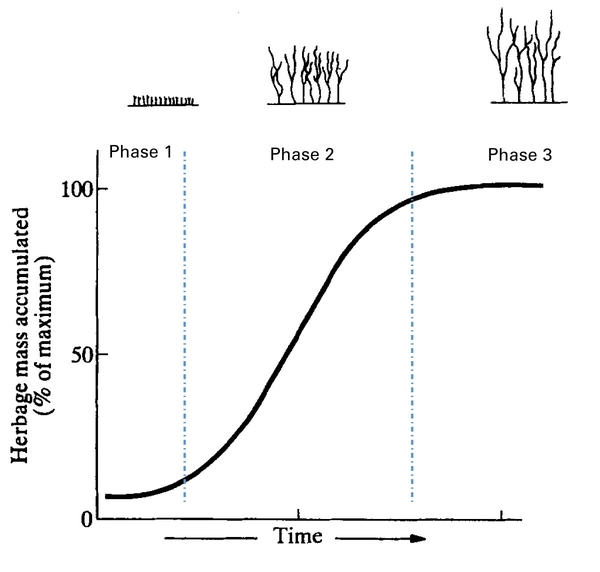
Figure 3. Forage mass accumulation during a regrowth recovery period. Phase 1: low accumulation rate, Phase 2: high accumulation rate, and Phase 3: little or no net accumulation rate due to balance between new growth and senescence of plant tissue.
Adapted from Hodgson, 1990; Saul and Chapman, 2002.
Summary
A variety of forages can be grown in North Carolina. Species adapted range from annual and perennial cool-season to warm-season grasses and legumes. Cool- and warm-season forages can be either annuals (live for one season) or perennials (live for multiple seasons). Forages provide feed for grazing animals and can be stored or shipped for subsequent feeding of livestock during periods of short supply for grazing. Forages can also be included as part of crop rotation systems, used as nutrient receiver crops for recycling animal wastes, grown for bioenergy purposes, and planted in riparian zones to help prevent contamination of water resources, among other uses. Each use has its own challenges and opportunities. Consequently, it is important to understand the factors and management practices that can have the greatest effect on success or failure of a production system that incorporates the use of forages and livestock.
Acknowledgment
This publication is a revision of an earlier version. The author would like to thank Paul Mueller and Jim Green, coauthors, for their earlier contributions.
Sources of Additional Information
Allen, V. G., C. Batello, E. J. Berretta, J. Hodgson, M. Kothmann, X. Li, J. MacIvor, J. Milne, C. Morris, A. Peeters, and M. Sanderson. 2011. “An International Terminology for Grazing Lands and Grazing Animals.” Grass and Forage Science 66:2–28.
Castillo, M. S., and Wallau, M. 2023. Stocking method and terminology in grazing management: Evaluation of assertions from educational, outreach, and engagement programs. Crop Science 63(2):495–500.
Hodgson, J. 1990. Grazing Management: Science into Practice. Longman Group, UK.
Kallenbach, R. L., C.J. Nelson, and J.H. Coutts. 2002. “Yield, Quality, and Persistence of Grazing- and Hay-type Alfalfa under Three Harvest Frequencies.” Agronomy Journal 94:1094–1103.
Mott, G. O. 1973. “Evaluating Forage Production.” In Forages: The Science of Grassland Agriculture, 3rd ed., edited by M. E. Heath, D. S. Metcalfe, and R. F. Barnes. 126–135. Ames, Iowa: Iowa State University.
Rouquette, F. M., Sollenberger, L. E., and Vendramini, J. M. B. 2023. Grazing management and stocking strategy decisions for pasture-based beef systems: Experimental confirmation vs. testimonials and perceptions. Translational Animal Science 7(1).
Saul, G. R., and D. F. Chapman. 2002. “Grazing Methods, Productivity, and Sustainability for Sheep and Beef Pastures in Temperate Australia.” Wool Tech. Sheep Breeding 50:449–464.
Sollenberger, L. E., and E. S. Vanzant. 2011. “Interrelationships among Forage Nutritive Value and Quantity and Individual Animal Performance.” Crop Sci. 51:420–432.
Sollenberger, L E., C. T. Auguridis, E. S. Vanzant, A. J. Franzluebbers, and L. B. Owens. 2012. “Prescribed Grazing on Pasturelands.” In Conservation Outcomes from Pastureland and Hayland Practices: Assessment, Recommendations, and Knowledge Gaps, edited by C. J. Nelson. Lawrence, KS: Allen Press.
Publication date: June 17, 2024
AG-789
N.C. Cooperative Extension prohibits discrimination and harassment regardless of age, color, disability, family and marital status, gender identity, national origin, political beliefs, race, religion, sex (including pregnancy), sexual orientation and veteran status.

